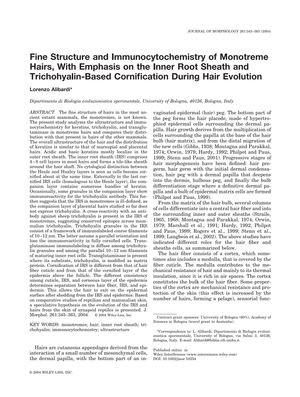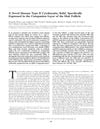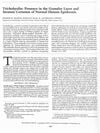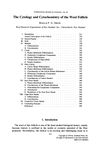Fine Structure and Immunocytochemistry of Monotreme Hairs, with Emphasis on the Inner Root Sheath and Trichohyalin-Based Cornification During Hair Evolution
July 2004
in “
Journal of morphology
”

TLDR Monotreme hair structure and protein distribution are similar to other mammals, but their inner root sheath cornifies differently, suggesting a unique evolution from reptile skin.
The study examined the ultrastructure and immunocytochemistry of monotreme hairs, focusing on keratins, trichohyalin, and transglutaminase, and compared them with marsupial and placental hairs. The findings showed that the overall ultrastructure and keratin distribution in monotreme hairs are similar to those of other mammals, with acidic and basic keratins primarily located in the outer root sheath. The inner root sheath (IRS) of monotreme hairs, consisting of 4-8 cell layers, does not show a clear distinction between the Henle and Huxley layers, and cells cornify simultaneously. Trichohyalin granules were observed in the IRS, with cross-reactivity to an antibody against sheep trichohyalin, indicating conserved epitopes across mammalian trichohyalin. Transglutaminase was present where trichohyalin is modified, suggesting its role in the cornification process. The study also noted that the cornification of the IRS is distinct from that of the hair fiber cuticle and the epidermis, facilitating the separation and exit of hair from the skin. The research proposed a hypothesis on the evolution of the IRS and hairs from the skin of synapsid reptiles.


